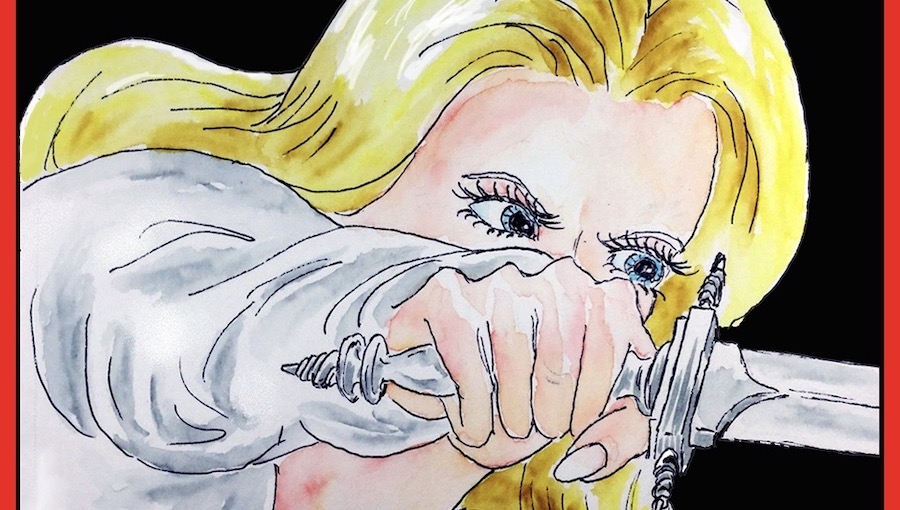The following is an interview with Paulus Linnaeus regarding the release of the graphic story, The Demonhuntress: 1888. In this interview, Fanbase Press Editor-in-Chief Barbra Dillon chats with Linnaeus about the creative process of bringing the story to life, what readers may take away from the story and characters, and more!
Barbra Dillon, Fanbase Press Editor-in-Chief: Congratulations on the release of your graphic story, The Demonhuntress: 1888! For those who may be unfamiliar, what can you tell us about the greater world and characters of The Demonhuntress which led to this new 1888 story?
Paulus Linnaeus: How often do you read a story in which there is a genuinely independent female lead who balances being feminine with strength and intelligence – and without being a victim, or being relegated to second position behind a male saviour, flighty and subsumed by shallow romantic distractions?
The Demonhuntress is a story of a young woman named Alexis (and Faustina, in earlier centuries) who reappears in various periods of history, and seeks to redress the wrongs done to her by revenging herself upon criminals who victimise others, and who happen to be connected with occult evil agents, of the kind you grew up wondering as to whether they were real: demons, ghosts, devil-worshippers… and no end of hateful people. She’s decisive, and often angry, sad or distant, but noble, and after suffering her own personal perdition, has no purpose left but to struggle, like the Vikings of old. And she is extremely tough, and smart, and beautiful, and misunderstood.
For 1888 – The Year of the Ripper, I researched the true facts about Jack the Ripper serial killings and thought: What if one of the women had fought back and changed the outcome of history in more ways than one?
BD: How would you describe your creative process in balancing the writing and illustrative duties, and what (or who) were some of your creative influences in terms of the characters and tone?
PL: This series was decades in the making, while I was sidetracked having a “responsible” career as a doctor. Back then, there were almost no female characters who weren’t victims and/or bimbos. I start with a dark premise, a mood, to build a story from concept art, and that evolves into evil elements up to no good. And then I imagine how Alexis – the resourceful woman – would deal with it all, how each character would interact and play her/his role according to his/her personality. It’s all about realism in the characters. Since I was able to hold a pencil, I’ve been drawing to express my moods through how I preferred the world, and characters, to behave. Writing, pencilling, inking, and shading/colouring… they all flow seamlessly together as the story develops its own direction. And dreams play a role in providing strong visual motifs.
There’s the undercurrent of inspiration for me that the underdog strengthens her/himself and can fight back, and at least partially dispense a degree of justice, like Nemesis, the goddess of divine retribution. And sometimes that intervention is positive. Alexis/Faustina drives the story in response to a conflict, and the conflict flows in response to her decisions and actions.
BD: At Fanbase Press, our #StoriesMatter initiative endeavors to highlight the impact that stories can have on audiences of various mediums. How do you feel that The Demonhuntress‘ story will connect with and impact readers?
PL: Bringing a realistic level of depth to characters, and hence the entire story arc and mood, are paramount in my creative work. My whole life, I was frequently dissatisfied with stories that were too “perfect;” in the real, non-Hollywood world, heroes are imperfect, situations are often morally ambiguous, and not all endings are particularly happy. Readers who are looking for escapism will see themselves in my main characters and their relationships; there is never any guarantee of victory or fairness, no matter how hard they may struggle. Sometimes, the evil side gets the upper hand. And like Nemesis, we all want to strike back and even the score.
As for the specific style of storytelling and artwork, readers who like classical gothic sagas, such as Frankenstein, will appreciate The Demonhuntress with its traditional look and feel. But my work appeals more to thinkers rather than drinkers!
BD: Are there any other upcoming projects on which you are working that you are able to share with our readers?
PL: Yes! The second graphic novel proper is nearing completion and release and will be in full colour this time. (Volume one had a very traditional black-and-white look and provides the origin story). Volume three is already in production and is set in Africa in the late 19th century. It introduces some sister characters… I could tell you more, but then I’d have to… you know… [unsettling laughter].
And I’ll be continuing to produce future episodes of The Demonhuntress, no matter what, until the day I die.
By the way, all my work is also available in French (LaChasseressededémons.com).
BD: Lastly, what would you like to tell fans who want to learn more about The Demonhuntress, The Demonhuntress: 1888, and your other work?
PL: Visit the website (TheDemonhuntress.com) for more details, including how to obtain your own copies and glimpses of work in progress through images and production videos in the studio, and even some original atmospheric music I’ve also composed. There’s more of that where it came from… but this is my lifelong project, so I’ll probably die before I create everything I want to! Fans can sign up for email/blog updates without ads or annoying strings attached… like Alexis, I respect others and don’t ever start a conflict – and she sure knows how to finish one!
And of course, there’s also the 1888 – Year of the Ripper graphic short story which is downloadable for free at TheDemonhuntress.com, so you can get a good taste.

